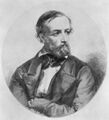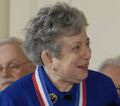Template:Selected anniversaries/February 13: Difference between revisions
No edit summary |
No edit summary |
||
| (9 intermediate revisions by the same user not shown) | |||
| Line 1: | Line 1: | ||
<gallery> | <gallery> | ||
|| *** DONE: Pics *** | |||
||1440: Hartmann Schedel born ... physician, humanist, historian, and one of the first cartographers to use the printing press. Pic: illustration. | ||1440: Hartmann Schedel born ... physician, humanist, historian, and one of the first cartographers to use the printing press. Pic: illustration. | ||
| Line 7: | Line 8: | ||
||1616: Priest and historian Anders Sørensen Vedel dies. He translated the Gesta Danorum by Saxo Grammaticus into Danish in 1575, and published the influential "Hundredvisebogen" in 1591. Tutor of Tycho Brahe. Pic. | ||1616: Priest and historian Anders Sørensen Vedel dies. He translated the Gesta Danorum by Saxo Grammaticus into Danish in 1575, and published the influential "Hundredvisebogen" in 1591. Tutor of Tycho Brahe. Pic. | ||
||1633: Galileo Galilei arrives in Rome for his trial before the Inquisition. | ||1633: Galileo Galilei arrives in Rome for his trial before the Inquisition. TO_DO | ||
||1672: Étienne François Geoffroy born ... physician and chemist. Pic. | ||1672: Étienne François Geoffroy born ... physician and chemist. Pic. | ||
| Line 13: | Line 14: | ||
||1728: John Hunter born ... surgeon and anatomist. Pic. | ||1728: John Hunter born ... surgeon and anatomist. Pic. | ||
File:Rudjer Boskovic.jpg|link=Roger Joseph Boscovich (nonfiction)|1787: Polymath [[Roger Joseph Boscovich (nonfiction)|Roger Joseph Boscovich]] dies. | File:Rudjer Boskovic.jpg|link=Roger Joseph Boscovich (nonfiction)|1787: Polymath [[Roger Joseph Boscovich (nonfiction)|Roger Joseph Boscovich]] dies. Boscovich was a physicist, astronomer, mathematician, philosopher, diplomat, poet, theologian, and Jesuit priest. | ||
||1804: French Army officer and inventor Claude-Etienne Minié born. He will gain fame for solving the problem of designing a reliable muzzle-loading rifle by inventing the Minié ball in 1846, and the Minié rifle in 1849. Pic. | ||1804: French Army officer and inventor Claude-Etienne Minié born. He will gain fame for solving the problem of designing a reliable muzzle-loading rifle by inventing the Minié ball in 1846, and the Minié rifle in 1849. Pic. | ||
File:Peter Gustav Lejeune Dirichlet.jpg|link=Peter Gustav Lejeune Dirichlet (nonfiction)|1805: Mathematician [[Peter Gustav Lejeune Dirichlet (nonfiction)|Peter Gustav Lejeune Dirichlet]] born. | File:Peter Gustav Lejeune Dirichlet.jpg|link=Peter Gustav Lejeune Dirichlet (nonfiction)|1805: Mathematician [[Peter Gustav Lejeune Dirichlet (nonfiction)|Peter Gustav Lejeune Dirichlet]] born. Dirichlet will important make contributions to number theory, analysis, and mechanics. He will also be one of the first mathematicians to give the modern formal definition of a function. | ||
||1852: John Louis Emil Dreyer born ... astronomer. Pic. | ||1852: John Louis Emil Dreyer born ... astronomer. Pic. | ||
||1865: Dugald C. Jackson born ... electrical engineer. He received the IEEE Edison Medal for "outstanding and inspiring leadership in engineering education and in the field of generation and distribution of electric power". Pic. | |||
||1865: Dugald | |||
||1865: Theodor Kober born ... aviation engineer who contributed to the building of the first Zeppelin. Pic: https://de.wikipedia.org/wiki/Theodor_Kober | ||1865: Theodor Kober born ... aviation engineer who contributed to the building of the first Zeppelin. Pic: https://de.wikipedia.org/wiki/Theodor_Kober | ||
||1880: Thomas Edison observes the Edison effect. | ||1880: Thomas Edison observes the Edison effect. TO_DO | ||
||1883: Mathematician Henry Wilbraham dies. He is known for discovering and explaining the Gibbs phenomenon nearly fifty years before J. Willard Gibbs did. Gibbs and Maxime Bôcher, as well as nearly everyone else, were unaware of Wilbraham's work on the Gibbs phenomenon. Pic search yes: https://www.google.com/search?q=henry+wilbraham | ||1883: Mathematician Henry Wilbraham dies. He is known for discovering and explaining the Gibbs phenomenon nearly fifty years before J. Willard Gibbs did. Gibbs and Maxime Bôcher, as well as nearly everyone else, were unaware of Wilbraham's work on the Gibbs phenomenon. Pic search yes: https://www.google.com/search?q=henry+wilbraham | ||
| Line 36: | Line 35: | ||
File:William Shockley.jpg|link=William Shockley (nonfiction)|1910: Physicist and inventor [[William Shockley (nonfiction)|William Shockley]] born. He will share the 1956 Nobel Prize in Physics for the invention of the [[Point-contact transistor (nonfiction)|point-contact transistor]]. | File:William Shockley.jpg|link=William Shockley (nonfiction)|1910: Physicist and inventor [[William Shockley (nonfiction)|William Shockley]] born. He will share the 1956 Nobel Prize in Physics for the invention of the [[Point-contact transistor (nonfiction)|point-contact transistor]]. | ||
||1919: William Nierenberg born ... physicist who worked on the Manhattan Project and was director of the Scripps Institution of Oceanography from 1965 through 1986. Pic. | ||1919: William Nierenberg born ... physicist who worked on the Manhattan Project and was director of the Scripps Institution of Oceanography from 1965 through 1986. Pic. | ||
| Line 44: | Line 41: | ||
File:Fay Ajzenberg-Selove.jpg|link=Fay Ajzenberg-Selove (nonfiction)|1926: Nuclear physicist [[Fay Ajzenberg-Selove (nonfiction)|Fay Ajzenberg-Selove]] born. She will do important experimental work in nuclear spectroscopy of light elements, authoring annual reviews of the energy levels of light atomic nuclei. | File:Fay Ajzenberg-Selove.jpg|link=Fay Ajzenberg-Selove (nonfiction)|1926: Nuclear physicist [[Fay Ajzenberg-Selove (nonfiction)|Fay Ajzenberg-Selove]] born. She will do important experimental work in nuclear spectroscopy of light elements, authoring annual reviews of the energy levels of light atomic nuclei. | ||
||1947: Erich Hecke dies ... mathematician. Pic. | ||1947: Erich Hecke dies ... mathematician. Pic. | ||
| Line 59: | Line 54: | ||
File:Jan Łukasiewicz.jpg|link=Jan Łukasiewicz (nonfiction)|1956: Mathematician and philosopher [[Jan Łukasiewicz (nonfiction)|Jan Łukasiewicz]] dies. Łukasiewicz' innovative thinking about the principle of non-contradiction and the law of excluded middle extended the bounds of traditional propositional logic. | File:Jan Łukasiewicz.jpg|link=Jan Łukasiewicz (nonfiction)|1956: Mathematician and philosopher [[Jan Łukasiewicz (nonfiction)|Jan Łukasiewicz]] dies. Łukasiewicz' innovative thinking about the principle of non-contradiction and the law of excluded middle extended the bounds of traditional propositional logic. | ||
||1967: American researchers discover the Madrid Codices by Leonardo da Vinci in the National Library of Spain. | File:Canopic Snickers Really Immortalizes.jpg|link=Canopic Snickers|1963: Discovery of '''[[Canopic Snickers]]''' an unlicensed transdimensional corporation which manifests itself as an ancient Egyptian candy bar with alleged life extension properties. | ||
||1967: American researchers discover the Madrid Codices by Leonardo da Vinci in the National Library of Spain. TO_DO | |||
||1974: Sagittarius A* discovered. It is a bright and very compact astronomical radio source at the center of the Milky Way, near the border of the constellations Sagittarius and Scorpius. It is part of a larger astronomical feature known as Sagittarius A. Sagittarius A* is thought to be the location of a supermassive black hole, like those that are now generally accepted to be at the centers of most spiral and elliptical galaxies. | ||1974: Sagittarius A* discovered. It is a bright and very compact astronomical radio source at the center of the Milky Way, near the border of the constellations Sagittarius and Scorpius. It is part of a larger astronomical feature known as Sagittarius A. Sagittarius A* is thought to be the location of a supermassive black hole, like those that are now generally accepted to be at the centers of most spiral and elliptical galaxies. | ||
| Line 65: | Line 62: | ||
||1980: Marian Adam Rejewski dies ... mathematician and cryptologist who reconstructed the Nazi German military Enigma cipher machine sight-unseen in 1932. The cryptologic achievements of Rejewski and colleagues Jerzy Różycki and Henryk Zygalski enabled the British to begin reading German Enigma-encrypted messages at the start of World War II. Pic. | ||1980: Marian Adam Rejewski dies ... mathematician and cryptologist who reconstructed the Nazi German military Enigma cipher machine sight-unseen in 1932. The cryptologic achievements of Rejewski and colleagues Jerzy Różycki and Henryk Zygalski enabled the British to begin reading German Enigma-encrypted messages at the start of World War II. Pic. | ||
||1992: Nikolay Bogolyubov dies | File:Nikolay_Bogolyubov.jpg|link=Nikolay Bogolyubov (nonfiction)|1992: Mathematician and physicist [[Nikolay Bogolyubov (nonfiction)|Nikolay Bogolyubov]] dies. His method of teaching, based on creation of a warm atmosphere, politeness, and kindness, is renowned in Russia as the "Bogolyubov approach". | ||
||1997: Robert Klark Graham dies ... eugenicist and businessman | ||1997: Robert Klark Graham dies ... eugenicist and businessman. Pic search: https://www.google.com/search?q=robert+klark+graham | ||
||1997: Mark Krasnosel'skii dies ... mathematician and academic | ||1997: Mark Krasnosel'skii dies ... mathematician and academic ... nonlinear functional analysis and its applications. Pic search: https://www.google.com/search?q=Mark+Krasnosel%27skii | ||
|File:Sir Tony Hoare 2011.jpg|link=Tony Hoare (nonfiction)|1997: Computer scientist and crime-fighter [[Tony Hoare (nonfiction)|Tony Hoare]] publishes new class of [[Gnomon algorithm functions]] which detect and prevent [[crimes against mathematical constants]]. | |File:Sir Tony Hoare 2011.jpg|link=Tony Hoare (nonfiction)|1997: Computer scientist and crime-fighter [[Tony Hoare (nonfiction)|Tony Hoare]] publishes new class of [[Gnomon algorithm functions]] which detect and prevent [[crimes against mathematical constants]]. | ||
| Line 81: | Line 78: | ||
||2016: Sir Erik Christopher Zeeman FRS dies ... mathematician, known for his work in geometric topology and singularity theory. Pic. | ||2016: Sir Erik Christopher Zeeman FRS dies ... mathematician, known for his work in geometric topology and singularity theory. Pic. | ||
</gallery> | </gallery> | ||
Latest revision as of 12:45, 13 February 2022
1787: Polymath Roger Joseph Boscovich dies. Boscovich was a physicist, astronomer, mathematician, philosopher, diplomat, poet, theologian, and Jesuit priest.
1805: Mathematician Peter Gustav Lejeune Dirichlet born. Dirichlet will important make contributions to number theory, analysis, and mechanics. He will also be one of the first mathematicians to give the modern formal definition of a function.
1910: Physicist and inventor William Shockley born. He will share the 1956 Nobel Prize in Physics for the invention of the point-contact transistor.
1926: Nuclear physicist Fay Ajzenberg-Selove born. She will do important experimental work in nuclear spectroscopy of light elements, authoring annual reviews of the energy levels of light atomic nuclei.
1956: Mathematician and philosopher Jan Łukasiewicz dies. Łukasiewicz' innovative thinking about the principle of non-contradiction and the law of excluded middle extended the bounds of traditional propositional logic.
1963: Discovery of Canopic Snickers an unlicensed transdimensional corporation which manifests itself as an ancient Egyptian candy bar with alleged life extension properties.
1992: Mathematician and physicist Nikolay Bogolyubov dies. His method of teaching, based on creation of a warm atmosphere, politeness, and kindness, is renowned in Russia as the "Bogolyubov approach".






